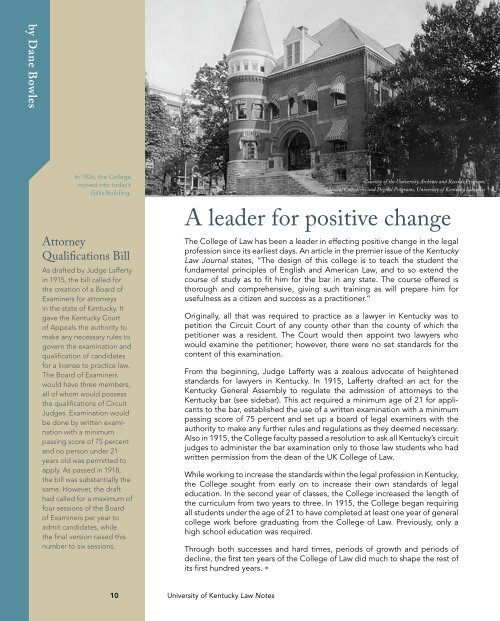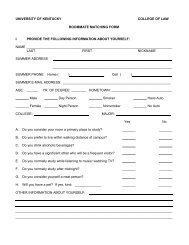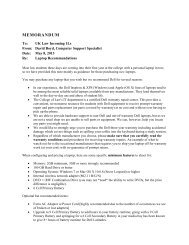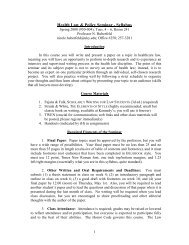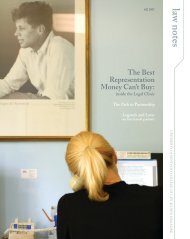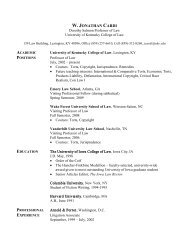law notes - University of Kentucky College of Law
law notes - University of Kentucky College of Law
law notes - University of Kentucky College of Law
Create successful ePaper yourself
Turn your PDF publications into a flip-book with our unique Google optimized e-Paper software.
y Dane Bowles<br />
In 1926, the <strong>College</strong><br />
moved into today’s<br />
Gillis Building.<br />
Attorney<br />
Qualifications Bill<br />
As drafted by Judge Lafferty<br />
in 1915, the bill called for<br />
the creation <strong>of</strong> a Board <strong>of</strong><br />
Examiners for attorneys<br />
in the state <strong>of</strong> <strong>Kentucky</strong>. It<br />
gave the <strong>Kentucky</strong> Court<br />
<strong>of</strong> Appeals the authority to<br />
make any necessary rules to<br />
govern the examination and<br />
qualification <strong>of</strong> candidates<br />
for a license to practice <strong>law</strong>.<br />
The Board <strong>of</strong> Examiners<br />
would have three members,<br />
all <strong>of</strong> whom would possess<br />
the qualifications <strong>of</strong> Circuit<br />
Judges. Examination would<br />
be done by written examination<br />
with a minimum<br />
passing score <strong>of</strong> 75 percent<br />
and no person under 21<br />
years old was permitted to<br />
apply. As passed in 1918,<br />
the bill was substantially the<br />
same. However, the draft<br />
had called for a maximum <strong>of</strong><br />
four sessions <strong>of</strong> the Board<br />
<strong>of</strong> Examiners per year to<br />
admit candidates, while<br />
the final version raised this<br />
number to six sessions.<br />
Courtesy <strong>of</strong> the <strong>University</strong> Archives and Records Program,<br />
Special Collections and Digital Programs, <strong>University</strong> <strong>of</strong> <strong>Kentucky</strong> Libraries<br />
A leader for positive change<br />
The <strong>College</strong> <strong>of</strong> <strong>Law</strong> has been a leader in effecting positive change in the legal<br />
pr<strong>of</strong>ession since its earliest days. An article in the premier issue <strong>of</strong> the <strong>Kentucky</strong><br />
<strong>Law</strong> Journal states, “The design <strong>of</strong> this college is to teach the student the<br />
fundamental principles <strong>of</strong> English and American <strong>Law</strong>, and to so extend the<br />
course <strong>of</strong> study as to fit him for the bar in any state. The course <strong>of</strong>fered is<br />
thorough and comprehensive, giving such training as will prepare him for<br />
usefulness as a citizen and success as a practitioner.”<br />
Originally, all that was required to practice as a <strong>law</strong>yer in <strong>Kentucky</strong> was to<br />
petition the Circuit Court <strong>of</strong> any county other than the county <strong>of</strong> which the<br />
petitioner was a resident. The Court would then appoint two <strong>law</strong>yers who<br />
would examine the petitioner; however, there were no set standards for the<br />
content <strong>of</strong> this examination.<br />
From the beginning, Judge Lafferty was a zealous advocate <strong>of</strong> heightened<br />
standards for <strong>law</strong>yers in <strong>Kentucky</strong>. In 1915, Lafferty drafted an act for the<br />
<strong>Kentucky</strong> General Assembly to regulate the admission <strong>of</strong> attorneys to the<br />
<strong>Kentucky</strong> bar (see sidebar). This act required a minimum age <strong>of</strong> 21 for applicants<br />
to the bar, established the use <strong>of</strong> a written examination with a minimum<br />
passing score <strong>of</strong> 75 percent and set up a board <strong>of</strong> legal examiners with the<br />
authority to make any further rules and regulations as they deemed necessary.<br />
Also in 1915, the <strong>College</strong> faculty passed a resolution to ask all <strong>Kentucky</strong>’s circuit<br />
judges to administer the bar examination only to those <strong>law</strong> students who had<br />
written permission from the dean <strong>of</strong> the UK <strong>College</strong> <strong>of</strong> <strong>Law</strong>.<br />
While working to increase the standards within the legal pr<strong>of</strong>ession in <strong>Kentucky</strong>,<br />
the <strong>College</strong> sought from early on to increase their own standards <strong>of</strong> legal<br />
education. In the second year <strong>of</strong> classes, the <strong>College</strong> increased the length <strong>of</strong><br />
the curriculum from two years to three. In 1915, the <strong>College</strong> began requiring<br />
all students under the age <strong>of</strong> 21 to have completed at least one year <strong>of</strong> general<br />
college work before graduating from the <strong>College</strong> <strong>of</strong> <strong>Law</strong>. Previously, only a<br />
high school education was required.<br />
Through both successes and hard times, periods <strong>of</strong> growth and periods <strong>of</strong><br />
decline, the first ten years <strong>of</strong> the <strong>College</strong> <strong>of</strong> <strong>Law</strong> did much to shape the rest <strong>of</strong><br />
its first hundred years. •<br />
10 <strong>University</strong> <strong>of</strong> <strong>Kentucky</strong> <strong>Law</strong> Notes


